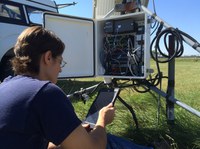NDAWN Celebrates 25 Years
(Click the image below to view a high-resolution image that can be downloaded)
The North Dakota Agricultural Weather Network (NDAWN) is celebrating 25 years of providing weather data to enhance crop management in North Dakota.
In 1989, North Dakotans were celebrating the centennial anniversary of statehood and suffering through the worst drought since the 1930s. Precipitation and other weather information was in high demand; however, getting weather data quickly was limited to the hourly reports from the Fargo, Grand Forks, Devils Lake, Jamestown, Bismarck, Minot, Williston and Dickinson airports. There were dozens of cooperative observers sending in their reports on a monthly basis, but real-time data was difficult to obtain.
“It was with this great need for timely and reliable weather data that John Enz, who was the state climatologist for North Dakota at the time, set up six automated weather stations,” says Daryl Ritchison, North Dakota’s assistant state climatologist. “These stations were set up to provide timely weather data to enhance crop management in North Dakota. The network gradually grew as the benefits of these weather stations spread through the agricultural community.”
A milestone occurred during the 1993 and 1994 growing seasons, when data from NDAWN was credited with helping save the potato crop.
It was the potato late blight model developed by the North Dakota State University Plant Pathology Department that integrated NDAWN data that was crucial in helping farmers control the disease. The late blight model is one of numerous such tools developed through the years for multiple crops that are being used as a resource by producers in the state and surrounding areas.
The network provides weather data that is used in developing various agricultural models such as late blight, degree-day and growth stage for barley, corn, canola, potatoes, sugar beets, sunflowers, wheat and other small grains. NDAWN users also can monitor irrigation scheduling, crop water use, and the conditions for sugar beet root maggot and other insect development.
“Research continues to improve the agricultural weather applications and the development of additional tools that will enhance the usefulness of the network,” Ritchison says. “It is estimated that NDAWN provides savings in the millions of dollars to agricultural producers in North Dakota each year.”
Although originally designed specifically for agriculture, NDAWN has proven useful in many other areas as well. In a state with some of the most extreme weather conditions in the U.S., access to current and past detailed local weather data can be a valuable resource for everyone.
From the six original weather stations, the network has grown to 75 stations, with additional stations scheduled to be added before the end of the year. With advances in technology, the data provided by the network can be seen in near real-time on the NDAWN website at http://www.ndsu.edu/ndawn. Anyone with Internet access and a computer, tablet or smartphone can access the information.
“As we celebrate our 25th anniversary providing vital weather information, we owe a debt of thanks to the NDSU Extension Service county agents and other cooperators for their voluntary contributions and assistance in keeping the stations operating throughout the year and in all kinds of weather,” Ritchison says.
NDSU Agriculture Communication – Sept. 3, 2014
| Source: | Daryl Ritchison, (701) 231-8209, daryl.ritchison@ndsu.edu |
|---|---|
| Editor: | Rich Mattern, (701) 231-6136, richard.mattern@ndsu.edu |


